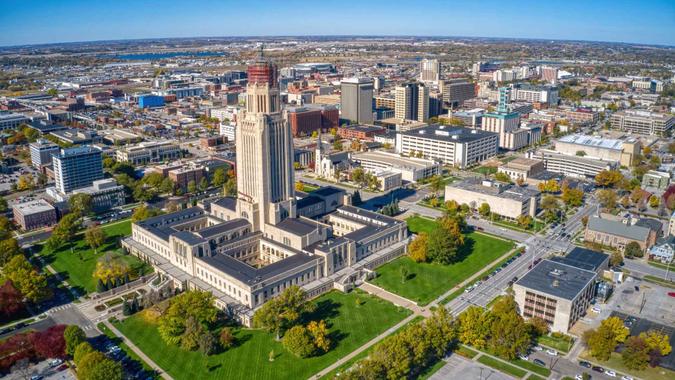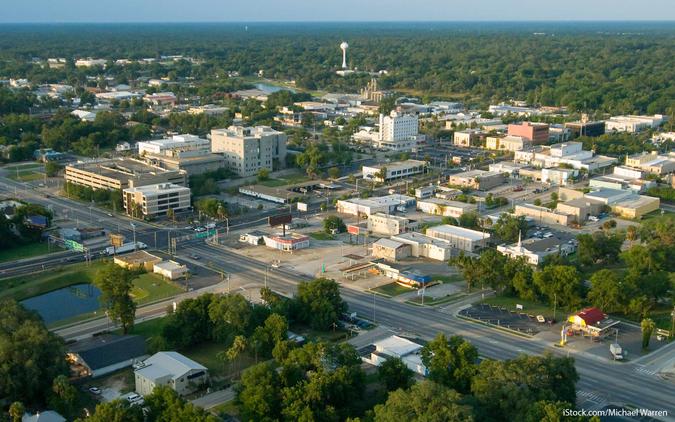Over the past five years, American home prices — along with the general cost of living — have boomed. According to Zillow, the average home price in July 2019 was $243,639. Five years later, that average has skyrocketed to $361,433.
This means the standard 20% down payment for the average American house is now a whopping $72,287. But there are still plenty of attractive housing markets across America that remain affordable — although you’ll still need at least $50,000 to make a 20% down payment.
To find affordable housing markets, GOBankingRates searched which of the 50 largest housing markets in the U.S. had average home values below $300,000, or more than 15% below the national average. Researchers then calculated the savings needed for various down payments and the salary needed to afford them, assuming that 30% or less of pre-tax income was used for housing expenses.
Check Out: 20 Best Cities Where You Can Buy a House for Under $100K
Read Next: 7 Reasons You Must Speak To a Financial Advisor Before Spending $50,000 or More
Since these markets are so affordable, it requires a salary of only $60,149 to get a mortgage with a 20% down payment in Norfolk, Virginia, the most expensive city on the list. In Pensacola, Florida, you’ll still need over $50,000 to afford a 20% down payment on the average home, but you’ll need a salary of just $52,757.
The good news about these housing markets is that since home prices are less than $300,000 on average, they’re still affordable monthly even with a down payment as low as 6%. If you earn about $62,000 in Pensacola, for example, you can afford the average home with just a 6% down payment. That’s a salary of just $833 per month more than you would need to afford a mortgage with a 20% down payment — and you’d be putting up $37,000 less.
The same is true even in Norfolk, the most expensive affordable market. While a 20% down payment would cost you nearly $60,000, a 6% down payment would be just under $18,000, a savings of about $42,000. Meanwhile, your monthly payment would go up by just $263.
Here’s a look at the 13 cities where homes are affordable but you’ll still need at least $50,000 for a 20% down payment, ranked in order from most to least expensive.
Also see 50 of the safest and most affordable cities to live in.

Norfolk, Virginia
- 2024 typical home value: $298,314
- Savings needed for 20% down payment: $59,663
- Annual mortgage with 20% down payment: $18,045
Learn More: 5 Types of Homes That Will Plummet in Value in 2024
For You: 6 Money Moves You Must Make If You Want To Be Like the Wealthy

Saint Paul, Minnesota
- 2024 typical home value: $297,162
- Savings needed for 20% down payment: $59,432
- Annual mortgage with 20% down payment: $17,975
Try This: 5 Cities Where Homes Will Be a Total Steal In Two Years

Huntsville, Alabama
- 2024 typical home value: $286,801
- Savings needed for 20% down payment: $57,360
- Annual mortgage with 20% down payment: $17,348

Omaha, Nebraska
- 2024 typical home value: $284,059
- Savings needed for 20% down payment: $56,812
- Annual mortgage with 20% down payment: $17,183

Lincoln, Nebraska
- 2024 typical home value: $282,568
- Savings needed for 20% down payment: $56,514
- Annual mortgage with 20% down payment: $17,092
Trending Now: 5 Worst Florida Cities To Buy Property in the Next 5 Years, According to Real Estate Agents

Grand Rapids, Michigan
- 2024 typical home value: $277,899
- Savings needed for 20% down payment: $55,580
- Annual mortgage with 20% down payment: $16,810

Ocala, Florida
- 2024 typical home value: $277,010
- Savings needed for 20% down payment: $55,402
- Annual mortgage with 20% down payment: $16,756

Houston
- 2024 typical home value: $276,581
- Savings needed for 20% down payment: $55,316
- Annual mortgage with 20% down payment: $16,730
Be Aware: I’m an Economist: Here’s My Prediction for the Housing Market If Trump Wins the Election

Greensboro, North Carolina
- 2024 typical home value: $266,182
- Savings needed for 20% down payment: $53,236
- Annual mortgage with 20% down payment: $16,101

San Antonio, Texas
- 2024 typical home value: $262,372
- Savings needed for 20% down payment: $52,474
- Annual mortgage with 20% down payment: $15,871

Columbus, Ohio
- 2024 typical home value: $262,138
- Savings needed for 20% down payment: $52,428
- Annual mortgage with 20% down payment: $15,857
Explore More: 6 Best Florida Suburbs to Buy Property in the Next 5 Years, According to Real Estate Agents

Pensacola, Florida
- 2024 typical home value: $261,651
- Savings needed for 20% down payment: $52,330
- Annual mortgage with 20% down payment: $15,827

Winston-Salem, North Carolina
- 2024 typical home value: $260,179
- Savings needed for 20% down payment: $52,036
- Annual mortgage with 20% down payment: $15,738
Methodology: For this piece, GOBankingRates looked at the 50 largest housing markets with 2024 typical home values below $300,000, as sourced from July 2024 Zillow data. GOBankingRates deemed this “affordable” as the national average is $361,433, thus $300,000 and below is well below the national average (15%+). With these cities isolated, GOBankingRates found the following: (1) savings needed for a down payment at 20%, 15%, 10% and 6%; (2) annual mortgage cost at 20%, 15%, 10% and 6%; and (3) salary needed to afford mortgage at 20%, 15%, 10%, and 6%, assuming that no more than 30% of pre-tax income should be put toward housing. For all mortgage calculations, GOBankingRates assumed a 30-year fixed rate at 6.47%, as sourced from Freddie Mac, with no P+I, property tax or HOA fees. All data was collected and is up to date as of Aug. 13, 2024.
More From GOBankingRates
- 3 Things You Must Do When Your Savings Reach $50,000
- I'm an Economist: Here's My Prediction for Social Security If Trump Wins the 2024 Election
- 5 Genius Things People With Healthy Savings Do
- Mechanics Explain Why You Should Never Buy These 6 Popular Car Brands
This article originally appeared on GOBankingRates.com: You’ll Need at Least $50K Saved To Buy a Home in These 13 Affordable Housing Markets
The views and opinions expressed herein are the views and opinions of the author and do not necessarily reflect those of Nasdaq, Inc.



